Insulation for a gas chimney: options for thermal insulation and technology of insulation of chimneys
Decided to insulate the chimney and can not choose a thermal insulation material? We will tell you what insulation for a gas chimney will work most effectively in various conditions. Consider the types of insulation and dwell on their technical characteristics.
To choose the most optimal option, we will first get acquainted with the designs of chimneys and the materials that are used for their construction. This will help us in choosing a thermal insulation protection, which will increase the efficiency of the gas boiler and ensure the maximum life of the chimney.
In the article we have proposed, the rules for conducting insulation work are given. Our recommendations will help determine the most rational, simple and convenient option to implement. The information provided will be extremely useful for independent masters.
The content of the article:
Why insulate the chimney of a gas boiler
When passing through the boiler pipe, heated gases lose temperature, giving part of their own heat to the walls of the structure. But at the same time, the gas must be brought out.
The draft quality largely depends on the temperature of the walls of the chimney pipe. With insufficient traction, there is a likelihood of smoke in the room and even poisoning with waste combustion products.
The efficiency of the discharge of combustion products, in other words, the quality of traction, depends on the speed of overcoming the moment of formation of condensate. This indicator is largely determined by the material from which it is made. chimney.
If a stainless steel or galvanized steel pipe is used as a chimney, the period of condensation formation takes about 2-3 minutes, but a standard brick chimney needs much more time - about half an hour.
At the time of the appearance of condensate and until its disappearance, active mixing of water with combustion products occurs, as a result of the reaction an acid solution appears. It is this acid that has a negative effect on the pipe, causing its destruction.
If an asbestos pipe or brickwork is used as a chimney, then residual condensate can be absorbed into their walls. In the absence of high-quality insulation, the accumulated moisture will freeze and destroy the chimney. Advantages of insulation of the chimney
If you properly insulate the chimney pipe from a gas boiler, you can identify a number of advantages. The main ones are:
- Reducing the effect of precipitation;
- Reducing heat loss during the heating period;
- Improving traction;
- Presentable appearance of the chimney;
- Reducing the volume of condensate formed on the outside of the chimney pipe.
Given the above advantages, it is obvious that the insulation of the gas boiler pipe is simply necessary. To carry out the work, various heaters can be used, each of which differs not only in physical characteristics, but also in the features of the work.
Rules for installing chimney systems
Before proceeding to the review of heaters and the rules for working with them, you need to understand the requirements that must be observed when installing the chimney. This point is very important, since violation of the norms can lead to the inability to operate the equipment.
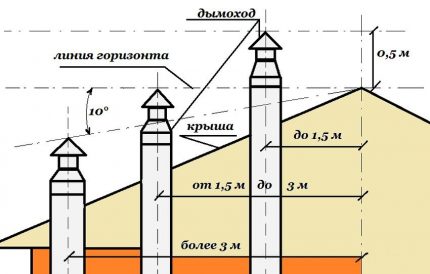
Chimneys must comply with the requirements of DBN B.2.5-20-2001 and SNiP 2.04.05-91. The basic requirements are as follows:
- The inner diameter of the chimney should be larger than the diameter of the outlet pipe of the gas boiler;
- The main pipe may not have curved or tapering sections, should be located vertically, a slope of not more than 30 degrees is allowed;
- A branch line may have no more than three turns;
- The distance from the outer surface of the pipe to the walls of combustible materials is 25 cm, to the walls of non-combustible materials - 5 cm;
- Insulation of the connections of the elements of the chimney should ensure complete tightness of the joint;
- Within the passage of the roof, the connection is not allowed (this part of the chimney must be integral);
- In places of turns, the arrangement of revision hatches is mandatory;
- Bottom part chimney pipe should be equipped with a condensate collection structure;
- The upper part should rise above the ridge of the roof by no less than 50 cm, the length of the chimney itself should provide high-quality traction.
Compliance with the norms and requirements for the construction of gas chimneys, not only ensures increased efficiency of equipment operation, extends the life of the chimney, but also guarantees fire safety and eliminates the risk of smoke in the room.
Types of gas chimneys
Depending on the material used, gas chimneys are divided into several types, while brickwork is practically not used for the removal of gases.
However, the brick is often used to tie the exhaust pipe. This is not a simple facing brick - it has a square shape, and its inside is a circular section.
Stainless steel chimneys
Metal chimneys are most popular. The most commonly used stainless steel, which is characterized by high corrosion resistance.
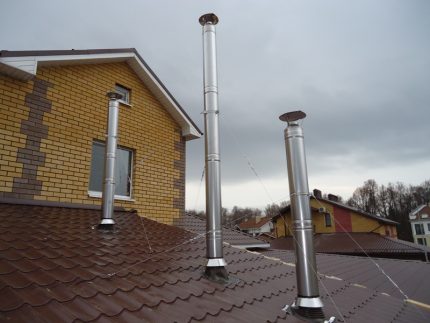
The main advantages of stainless steel structures:
- Resistance to condensed moisture;
- Resistance to atmospheric precipitation;
- Chemical resistance to soot resulting from gas combustion;
- Resistance to high temperatures;
- Internal smooth surface reduces the coefficient of friction, providing unhindered passage of gases with minimal deposition of soot;
- Light weight allows the use of standard hardware;
- Simple installation eliminates the complexity of work with significant destruction of the walls;
- Pretty affordable cost.
Conventional stainless steel pipes are not recommended. This is due to the fact that chimneys are made of special grades of stainless steel, which, thanks to the introduction of alloying elements, are highly resistant to acids that appear as a result of condensation.
Brick chimney device
Currently, a brick chimney is used much less often, because It is built mainly for brick furnaces, and gas models are actively displacing them. In addition, his device takes a lot of time.
Along with this brick chimney, the following disadvantages are inherent:
- Rough inner surface, contributing to the accumulation of soot and reduce traction;
- Instability to corrosion by acid. Due to the hygroscopicity of the material, condensate is absorbed and rapidly ruptures;
- The complexity of the construction. Masonry from piece building materials takes much longer than assembling metal or ceramic modules.
You can eliminate the negative qualities of a brick chimney by inserting a sleeve in the form of a pipe made of asbestos or stainless steel.
Chimney from asbestos-cement pipes
Earlier, asbestos-cement pipes were very widely used in the installation of chimneys of gas boilers. Despite the porosity of the material, the roughness of the inner walls and the far from ideal cross-section, the popularity of asbestos-cement pipes is due to their low cost.

To avoid these shortcomings, the chimney made of asbestos-cement pipes should be as straight as possible with sealed joints. It is not enough simple cement mortar, dried joints need to be treated with sealant or use special tight clamps.
In general, the work is simple. With proper sealing of the joints, the chimney from asbestos-cement pipes will not yield to its stainless steel counterpart. However, it will serve during active operation no more than 3-5 years, after which it requires a mandatory replacement.
Smoke duct made of ceramic pipes
Chimneys from ceramic pipes are distinguished by reliability, durability, high corrosion resistance to aggressive substances and temperature extremes.
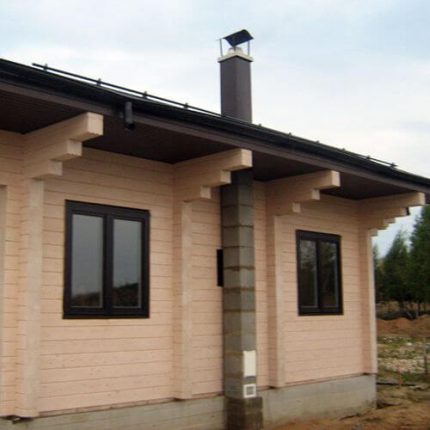
However, along with this, they have their drawbacks - high weight, the mandatory construction of a separate foundation and high cost. But all these shortcomings ceramic chimneys overlap for decades of reliable and stable operation.
Types of insulation for a chimney
The choice of heaters for gas chimneys is quite limited due to the high requirements for heat resistance and fire safety.
Obviously, the popular sheet polystyrene foam, polystyrene foam and similar polymers will not work. When exposed to high temperatures, they can not only easily deform, but also ignite if a spark gets on them.
Insulation for a gas chimney must comply with the following requirements:
- The minimum heat conductivity indicator that provides fire safety standards;
- Light weight to reduce the load on the roof;
- Plasticity and flexibility for simple thermal insulation of geometrically complex sections;
- Neutrality to the effects of chemical media, precipitation and condensate;
- Long term of operation.
An ideal option is the device for thermal insulation of the chimney of a gas boiler using mineral heat insulators. Because of its cheapness, bulk materials were most often used earlier, having lost their positions due to low efficiency and large mass.
They lost the lead to cotton insulation made from minerals of basalt wool and fiberglass. These materials are characterized by high fire resistance, they are able to withstand temperatures of more than 400 degrees.
Mineral Wat Group
The mineral wool class includes materials: fiber from slag, fiberglass, stone wool. Each of the three groups is distinguished by its structure - the thickness and length of the fibers, resistance to stress, moisture resistance and fire safety.
To understand the technical characteristics of mineral wool, we will consider each of the groups separately.
Glass wool specifications
The thickness of the glass wool fibers is in the range of 5-15 microns with a length of 15-50 mm. It is characterized by elasticity and durability, you need to work with the material as carefully as possible, since glass fibers can not only dig into the skin, but also get into the airways.
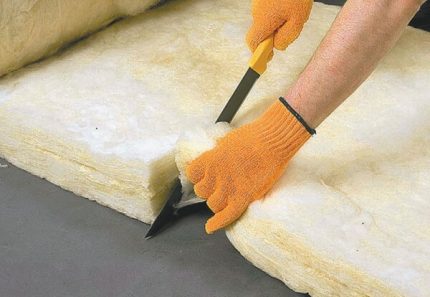
Glass wool has an average hygroscopicity, the maximum heating temperature is 450 ° C. The coefficient of thermal conductivity is 0.03 - 0.052 watts per meter per Kelvin.
Specifications slag
The thickness of the slag fibers is in the range of 4 to 12 microns with a fiber length of 16 mm, the base of the insulation is blast furnace slag. The material is highly brittle and hygroscopic.
Despite the permissible heating temperature of 300 ° C, slag is unsuitable for insulation of a gas chimney due to the high absorption of moisture. In addition, the material is characterized by residual acidity, which has a negative effect on the metal.
Technical characteristics of stone wool
Thermal insulation material is made from gabbro-basalt rock waste. In fact, this is a product of mineral fibers, which has a different name - stone wool. The fiber thickness does not exceed 7 microns with a length of up to 50 mm.
In the production of insulation, grinding of the rock is carried out, followed by melting and drawing out the finest “threads”. After preheating to 300 degrees, the threads are passed through the press twice. As a result, the resulting material is characterized by high fire resistance and strength.
Stone or basalt wool is characterized by the following characteristics:
- Low thermal conductivity - 0.032 - 0.048 watts per meter per Kelvin;
- Hydrophobicity - moisture cannot get inside, as it settles on the surface. Resistance to atmospheric precipitation.
- Resistance to deformation - achieved due to the mixed arrangement (vertical and horizontal) of fibers, withstands loads up to 80 kPa;
- High fire resistance - the material can withstand temperatures of more than 1100 ° C, without losing strength. Taking into account that the soot ignition temperature does not exceed 1000 ° С, the material is suitable for warming almost any smoke removal system.
Basalt or stone wool is an ideal solution for insulating a gas chimney, but due to its lower cost, glass wool can also be used.
Form of release of heaters
Mineral wool release form - mats or rolls, along with this they can be supplemented with special functional layers and elements. For example, a foil layer can not only reflect heat, but also prevent the weathering of fibers.
Sometimes it will be justified to use lamella mats cut in the form of strips - they easily repeat the shape of the chimney. High practicality is characterized by rolled materials and stitched mineral plates. For chimneys of circular cross section, an ideal solution would be a heater in the form of cylinders made of basalt fiber.

The cylinders have a cut and are a kind of opening sleeve. It is enough to deploy the cylinder with your hands and just put it on the pipe. Such heaters have different thicknesses and can have a foil coating on the outside.
Next, we consider in more detail the features of insulation of each type of chimney and the rules for the use of heaters.
Methods of warming a gas chimney
Insulation requires only that part of the chimney, which is located on the street or in an unheated attic. At the same time, pipes fixed to the facade of the building must be completely insulated, including the horizontal section passing through the wall.
The choice of insulation method is determined by the material from which the gas chimney is built. Work on the insulation of the chimney from a gas boiler depends not only on its design, but also on the selected material.
Insulation of asbestos cement gas chimney
Asbestos-cement pipe can be insulated in three fundamentally different ways. Mineral wool, brickwork or plaster are suitable for their implementation.
Masonry insulation
Warming with masonry with filling the voids with bulk insulation is allowed, but the process is quite time-consuming and time-consuming.
This method is most often resorted to if there is already a brick chimney, and an asbestos cement or galvanized steel pipe is used as a sleeve.
Chimney insulation by plastering
Asbestos-cement pipe has high adhesion, therefore, as a warming, you can resort to plastering. Before performing work on the pipe, it is necessary to fix the reinforcing mesh.
The solution is prepared in the following proportion:
- 3 parts sieved slag;
- 1 part of cement;
- 2 parts lime with water.
The solution should have a thick plastic consistency. The first layer is applied with a thickness of 20-30 mm. All subsequent layers are applied only after the previous one dries. Before painting or whitewashing, the surface of the plaster must be sanded, and cracks that have appeared should be puttied.
Mineral wool insulation
The work is reduced to fixing on the outside of the pipe a layer of mineral wool. Before starting work, the pipe must be cleaned of dust and a layer of rolled insulation must be fixed with clamps. Given that mineral wool is capable of absorbing moisture, it is recommended to hide it under a galvanized steel casing.
In order to save money in the attic, you can do without a steel casing, but under the influence of atmospheric precipitation, the service life of mineral wool is unlikely to exceed 2-3 years.
Steel chimney insulation
Stainless steel chimneys are essentially two pipes of different diameters, the space between which is filled with insulation. You can buy a ready-made design in the form of a sandwich pipe. In this case, it is sufficient to carry out installation work without insulation, since the insulation has already been installed initially.
But the cost of sandwich pipes is high enough to save you can build similar design yourself. To do this, it is enough to wrap the inner pipe with a roll of mineral wool insulation or use a finished shell or cylinders of the same material.Instead of stainless steel, the outer pipe can be galvanized.
Another method that allows you to perform insulation within the attic is the installation of a wooden box using backfill. As bulk materials, you can use slag, sand, expanded clay.
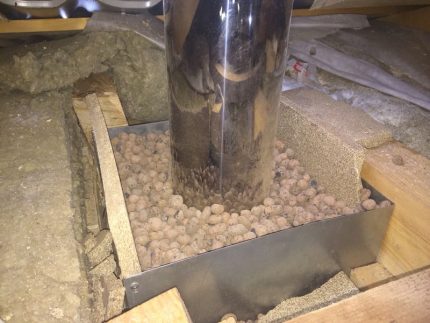
In places of contact of the box with the roof or crate, it is necessary to install protection from steel sheets to prevent fire.
Brick chimney insulation
Brick chimney is traditionally insulated with plastering with preliminary fixing of the reinforcing mesh. The advantages of this method are low cost, the disadvantages are low efficiency. Heat loss is reduced by no more than a quarter.

It is possible to increase the efficiency of insulation of a brick chimney with the help of mineral wool mats.
The insulation should fit snugly against the plastered chimney, so the appearance of cold bridges is eliminated. Given the fact that mineral wool easily absorbs moisture, it must be covered with a layer of vapor barrier film, followed by fixing with construction tape.
Conclusions and useful video on the topic
Insulation of a steel gas chimney:
To ensure high-quality removal of gases resulting from combustion, insulation of the chimney is a vital necessity. Mineral wool is considered an ideal insulation material, it is this material that meets all the requirements of a high-quality and reliable insulation.
Acceleration of installation work will help the acquisition of ready-made insulated modules. But you can independently conduct insulation with basalt wool, and get an analogue of a sandwich pipe for less cost. The use of cylinders and shells made of mineral wool can significantly accelerate the process of warming the chimney.
Do you want to share your own experience in thermal insulation of a gas boiler pipe? Do you have useful information that will be useful to site visitors? Please write comments in the block form below, ask questions, post a photo on the topic of the article.

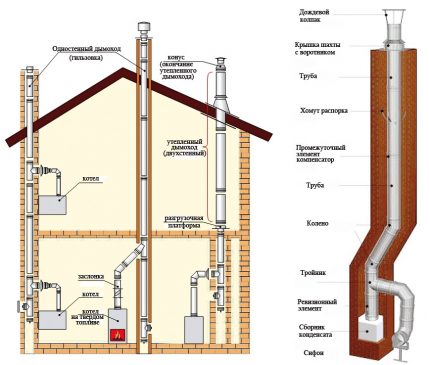
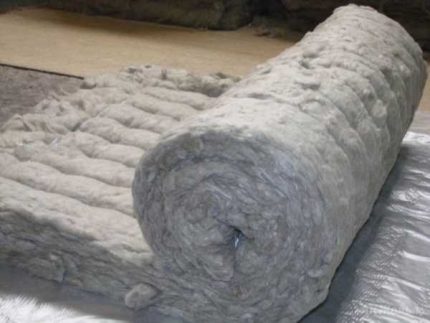
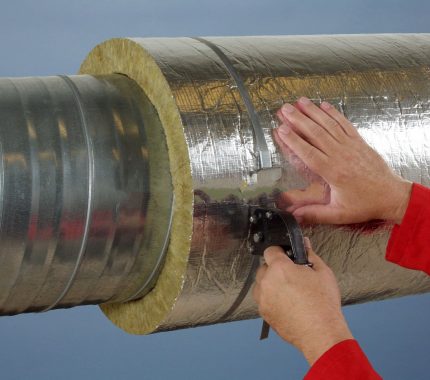
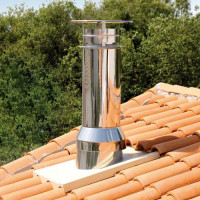 Which pipe to choose for the chimney: regulatory guidelines and rules
Which pipe to choose for the chimney: regulatory guidelines and rules 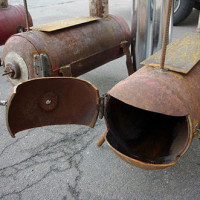 Do-it-yourself gas stove from a gas cylinder: diagrams, drawings + step-by-step guide
Do-it-yourself gas stove from a gas cylinder: diagrams, drawings + step-by-step guide 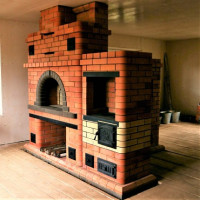 Russian stove with stove: masonry technology of the Russian stove with diagrams and detailed procedures
Russian stove with stove: masonry technology of the Russian stove with diagrams and detailed procedures  How to assemble and install a do-it-yourself sandwich chimney: installation instructions
How to assemble and install a do-it-yourself sandwich chimney: installation instructions 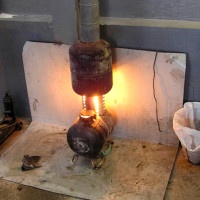 The furnace for working out of the pipe: how to make an effective furnace for used oil from improvised materials
The furnace for working out of the pipe: how to make an effective furnace for used oil from improvised materials 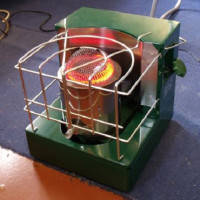 DIY miracle oven for a garage in a diesel fuel: step-by-step instructions for the construction
DIY miracle oven for a garage in a diesel fuel: step-by-step instructions for the construction  How much does it cost to connect gas to a private house: the price of organizing gas supply
How much does it cost to connect gas to a private house: the price of organizing gas supply  The best washing machines with dryer: model rating and customer tips
The best washing machines with dryer: model rating and customer tips  What is the color temperature of light and the nuances of choosing the temperature of the lamps to suit your needs
What is the color temperature of light and the nuances of choosing the temperature of the lamps to suit your needs  Replacement of a geyser in an apartment: replacement paperwork + basic norms and requirements
Replacement of a geyser in an apartment: replacement paperwork + basic norms and requirements